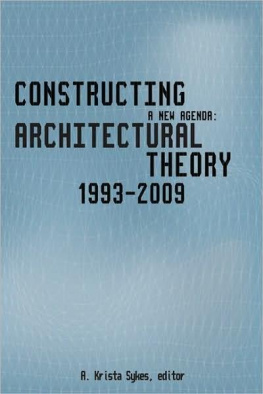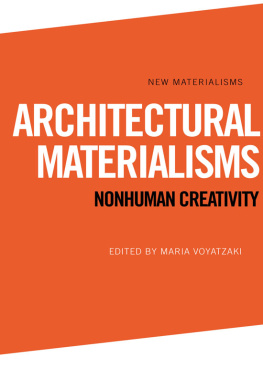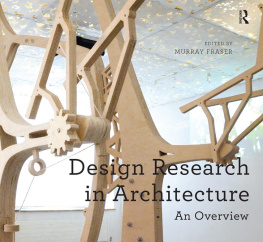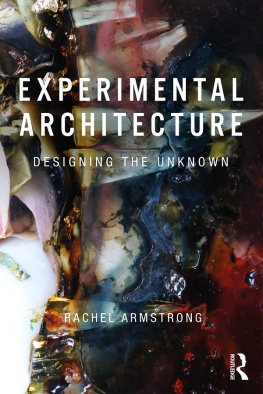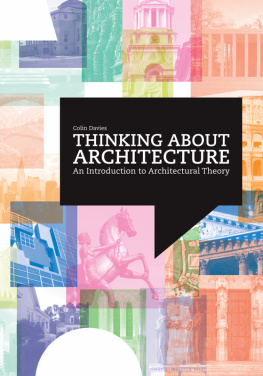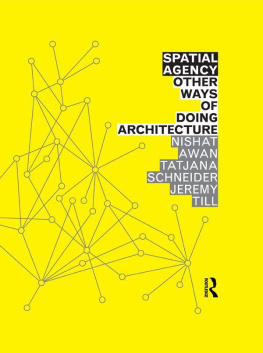CONTENTS GREG LYNN CONGRESS FOR THE NEW URBANISM DEBORAH BERKE STANDFORD KWINTER JOHN RAJCHMAN SAMUEL MOCKBEE STAN ALLEN REM KOOLHAAS JEFFREY KIPNIS NORMAN FOSTER, JAN KAPLICKY, RICHARD ROGERS, KEN YEANG, AND THOMAS HERZOG SASKIA SASSEN ROBERT SOMOL AND SARAH WHITING MICHAEL SPEAKS WILLIAM MCDONOUGH AND MICHAEL BRAUNGART WILLIAM J. MITCHELL FREDERIC JAMESON ANTOINE PICON ROEMER VAN TOORN ANTHONY VIDLER K. MICHAEL HAYS REINHOLD MARTIN STEVEN A. MOORE GLENN MURCUTT, INTERVIEWED BY CYNTHIA DAVIDSON ARIE GRAAFLAND KARL S. CHU REISER + UMEMOTO SYLVIA LAVIN JOHN MCMORROUGH K. MICHAEL HAYS
CONSTRUCTING A NEW AGENDA
CONSTRUCTING
A NEW
AGENDA

ARCHITECTURAL
THEORY
19932009

A. KRISTA SYKES, EDITOR
Princeton Architectural Press New York
Published by
Princeton Architectural Press
37 East 7th Street, New York, NY 10003
For a free catalog of books call: 1-800-722-6657
Visit our website at www.papress.com
2010 A. Krista Sykes
All rights reserved
Printed and bound in the United States
13 12 11 10 4 3 2 1 First edition
No part of this book may be used or reproduced in any manner without written permission from the publisher, except in the context of reviews.
Every reasonable attempt has been made to identify owners of copyright.
Errors or omissions will be corrected in subsequent editions.
Editor: Carolyn Deuschle
Cover design: Paul Wagner
Typesetting print edition: Bree Anne Apperley
Special thanks to: Nettie Aljian, Sara Bader, Nicola Bednarek, Janet Behning, Becca Casbon, Carina Cha, Tom Cho, Penny (Yuen Pik) Chu, Russell Fernandez, Pete Fitzpatrick, Wendy Fuller, Jan Haux, Nancy Eklund Later, Linda Lee, Laurie Manfra, John Myers, Katharine Myers, Steve Royal, Dan Simon, Andrew Stepanian, Jennifer Thompson, Joseph Weston, and Deb Wood of Princeton Architectural Press Kevin C. Lippert, publisher
Library of Congress Cataloging-in-Publication Data
Constructing a new agenda for architecture : architectural theory 19932009 / A. Krista Sykes, editor. 1st ed.
p. cm.
Includes bibliographical references.
ISBN 978-1-56898-859-7 (alk. paper)
1. ArchitecturePhilosophy. I. Sykes, Krista.
NA2500.C598 2010
720.1dc22
ISBN 978-1-61689-082-7 (digital)
2009030430
A long time agopeople used simply to drop things from time to time. But nowadays we have physicists to inform us of the laws of gravity by which objects fall; philosophers to doubt whether there are really any discrete objects to be dropped at all; sociologists to explain how all this dropping is really the consequence of urban pressures; psychologists to suggest that we are really all trying to drop our parents; poets to write about how all this dropping is symbolic of death; and critics to argue that it is a sign of the poets castration anxiety. Now dropping can never be the same again. We can never return to the happy garden where we simply walked around dropping things all day without a care in the world. What has happened, rather, is that the practice has now been forced to take itself as its own object of enquiry. Theory is just human activity bending back upon itself, constrained into a new kind of self-reflexivity. And in absorbing this self-reflexivity, the activity itself will be transformed.
Terry Eagleton, The Significance of Theory
ACKNOWLEDGMENTS
Numerous individuals had a hand in this book. I thank Nancy Eklund Later for initiating this project and guiding it forward; Jennifer Thompson and Carolyn Deuschle for bringing the book to fruition; Lee Gray for his never-failing guidance and advice; Michael Hays, John McMorrough, and Mark Morris for their thoughts and suggestions on content; Michael Hays for generously contributing the afterword; Arie Graafland, Jeff Kipnis, John McMorrough, Roemer van Toorn, and Sarah Whiting for the extra efforts regarding their essays; and all of the authors for their permission to be included in this collection. Above all I am grateful to Joshua and Sophia for their patience, support, and enthusiasm. This work is dedicated to them.
PREFACE
This collection builds on the foundation established by Kate Nesbitt in Theorizing a New Agenda for Architecture: An Anthology of Architectural Theory, 19651995 . Like its parent compilation, the present work contains a variety of textsin this case essays, book chapters, interviews, manifestos, and questionnaireswritten by architects, theorists, historians, critics, and interdisciplinary scholars. Together they offer an overview of the myriad tendencies that have characterized architectural theory in the years since the publication of Nesbitts book.
While the two volumes share a similar intentto gather in one place recent significant writings on architectural theorytheir modes of organization differ. As opposed to the thematic divisions offered by Nesbitt, here the twenty-eight texts, each preceded by a short introduction, appear in chronological order. This reflects the lack of a single theoretical discourse during the period in question. Furthermore, the chronological organization avoids a priori classifications, which can inadvertently limit the readers textual interpretations and forestall new thematic groupings; this can be particularly helpful for instructors eager to trace motifs tailored for specific courses. In addition to instructors and students, this collection is directed toward architectural professionals and those attentive to the ways in which contemporary architectural thought influences and is influenced by society in general. As Nesbitt noted in her preface, the issues raised [here] are fundamental to understanding the course of architecture in the recent past, and should be of interest to all scholars involved in the analysis and critique of cultural production.
We are still in the midst of a transitional period in architecture that began in the 1990s. This makes the exploration of the contemporary architectural situationas well as any attempt to intellectually frame ita rather difficult proposition, as there is no obvious vantage point from which to view the landscape of the recent past. Nevertheless, for this anthology I sought to select material that addresses architecture as a whole. Due to space constraints, I have largely excluded writings focused specifically on urbanism and urban planning, even though architecture and urbanism necessarily and inevitably share territory. The texts that do appear in this collection are mixeda combination of writings that have already impacted architectural discourse and others that may prove, in retrospect, to be prescient of or decisive for our contemporary situation. In conjunction, I believe these readings will provide valuable insight into the present moment and offer a basis for future architectural thought and practice.
Notes
Kate Nesbitt, Preface, in Theorizing a New Agenda for Architecture: An Anthology of Architectural Theory, 19651995 (New York: Princeton Architectural Press, 1996), 13. INTRODUCTION
The end of the twentieth century witnessed the publication of two anthologies dedicated to architectural theory: in 1996, Kate Nesbitts Theorizing a New Agenda for Architecture: An Anthology of Architectural Theory, 19651995 ; and two years later, K. Michael Hayss Architecture Theory Since 1968 .
Theory as a code or framework for architectural thought has existed for centuries, often cited as originating with Vitruvius in the first century BCE . Yet the theory referred to by Nesbitt and Hays relates to a specific movement that began in the 1960s and strives to reconstitute the architectural discipline through mediatory conceptsderived from fields such as philosophy, linguistics, psychology, and anthropologythat simultaneously connect architecture to other social realms and (attempt to) claim for architecture its own unique territory. Architectural theory as such encompasses many overlapping and often conflicting tendencies (for example semiotics, structuralism, and phenomenology), which in turn have given rise to the more recent historicist and deconstructivist camps.

